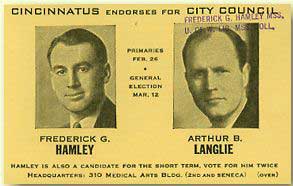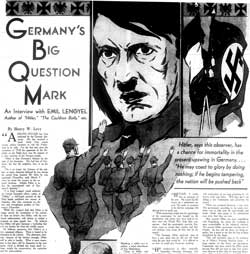Right-Wing Radicalism and Fascism

A flyer for the New Order of Cincinnatus (Courtesy of the University of Washington Library, Special Collections)
Though the left-wing movements were far more visible and effective, Washington State also saw the emergence of conservative and fascist organizations with their own responses and solutions to the crisis.
The New Order of Cincinnatus, a men-only organization launched in 1933, gained legitimacy throughout the state, while providing future governor Arthur Langlie with his start in politics. Attacking high taxes and championing moral and political reform, the organization drew fire from the left which saw it as a potential vigilante or proto-fascist threat.
Those fears proved unfounded, and members of Cincinnatus like Langlie entered the Republican Party and used their political experience from the 1930s to revitalize the Republican Party in the 1940s as a challenge to the New Deal Democrats.
If the Order of Cincinnatus was not a fascist organization, similar worries about the Silver Shirt Legion of America were well-placed. The Silver Shirts drew their inspiration and paramilitary style directly from Italian fascism and German Nazism, and Washington State hosted one of their largest chapters. Indeed, fascism was not always seen as a threat by Seattle elites: a careful look at Seattle's mainstream daily news show that a turn against Hitler's policies and European fascism was not evident until after Hitler's initial rise to power.

A Seattle Times article from April 23, 1932, in which an expert reassures readers that Hitler will follow moderate policies.
Anti-communism would became a large national presence in the mid-1940s in response to the radicalism, strikes, and influence of Communists in the social movements and political reforms of the 1930s. The anti-Communist witchhunts usually associated with McCarthyism in the 1950s began in Washington in 1930, as Hamilton Fish and the Congressional Committee came to Washington to hold hearings on the impact of Communists in labor and state politics. Anti-Communists also worked to hinder the efforts of radical faculty at the University of Washington to unionize.
We have detailed reports about right-wing radicalism, fascism, and anti-Communism:
 |
The New Order of Cincinnatus and the Role of Non-Partisan Conservatism in Depression-era Seattle Politics, by Emma Lunec
The conservative New Order of Cincinnatus, an anti-corruption and pseudo-fascist men's political organization, fostered conservative politicians who would revitalize the state Republican Party in the late 1930s to challenge the Democratic New Deal. |
 |
The Birth of Anticommunist National Rhetoric: The Fish Committee Hearings in 1930s Seattle, by Crystal Hoffer
The Fish Committee hearings in 1930s Seattle were a preface to the anti-communist trials of the late 1940s and 1950s.
|
 |
Communism, Anti-Communism, and Faculty Unionization: The American Federation of Teachers' Union at the University of Washington, 1935-1948, by Andrew Knudsen
The founding of an AFT-affiliated faculty union at the University of Washington allowed faculty job security and redress during the economic crisis. Yet the radical and sometimes Communist politics of its members made the union susceptible to federal anti-Communist repression by the 1940s.
|
 |
Nazism in the 1933 Seattle Times, by Michael Branscum
This paper traces the changing newspaper coverage in the Seattle Times of Hitler's rise to power, paralleling the federal government's own policies of initial support and lack of concern over reports of Nazi Germany's attacks on civil liberties. |






